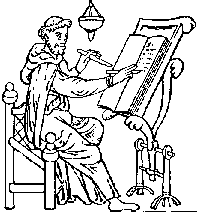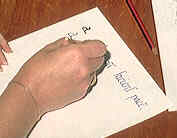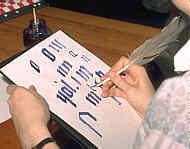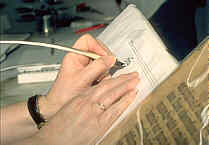




If you are looking at this page without frames, there is more information about medieval writing to be found by going to the home page (framed) or the site map (no frames).
| Tools and Materials | ||||
| The materials of the scribe remained remarkably consistent throughout the middle ages, if illustrations of scribes are anything to go by. The scribe basically needed tools to write with, a membrane to write on, concoctions to produce the colour and a nice ergonomic working environment; well, as good as the medieval era could provide. (See Bischoff 1990, Jackson 1981 ). |  |
|||
 |
In Roman antiquity, writing was done with a reed pen. However, throughout the medieval era a quill was evidently the more usual instrument. While old schoolbooks, not to mention modern TV programs, frequently illustrate people writing with an extravagant plume that appears to have been freshly plucked, there was some preparation involved. | |||
| A Palaeography Summer School participant demonstrates that writing with a reed pen is a perfectly viable option. | ||||
 |
The business end of a strong feather, such as a pinion of a goose, was first buried in hot sand to change the structure and make it stronger and less brittle. Usually the flights of the feather were removed, making it easier to handle but less photogenic and romantic. The nib was cut to shape with a small knife, splitting the end like the nib of a modern calligraphic pen or fountain pen. The pen was then ready for use. The shaping procedure was regularly repeated to sharpen the nib during use. | |||
| A participant at a Palaeography Summer School at the University of Tasmania in 1996 tries her hand at writing with a quill pen. She is constrained by the fact that the quill has not been properly prepared, having been salvaged only a day or two before from a National Park where some Cape Barren geese were moulting. | ||||
| The most common surviving membrane material for medieval manuscripts was parchment or vellum, made from the skins of sheep, goats or calves. Paper was used for some manuscripts, especially those of a secular nature, in the later part of the middle ages, first appearing in Europe in the 13th century. In the earlier medieval period, the chancery of the Merovingian kings used papyrus, as was used during the Roman era, until the 7th century. The papal chancery retained the use of papyrus until the 10th century. | ||||
| There were various formulations for ink, of which the most commonly encountered are iron gall ink, which is brown, and carbon ink, which is black. Coloured and metallic inks were also employed for special purposes. Illuminators mixed their own paints and used gold leaf for gilding. | ||||
 |
Scribes are usually depicted in the illustrations in medieval manuscripts seated at a sloping desk equipped with ink horns, holding a quill pen in one hand and their small knife in another. The knife was not only for recutting the quill, but for minor erasures on the manuscript, and possibly also to hold the vellum in place as they wrote, which would be better than leaving greasy finger marks on the parchment. Sometimes the book they are copying from is shown on its own separate bookstand. They also had pumice stones for smoothing the vellum, and equipment for pricking and ruling the pages in preparation for writing. | |||
| A left handed would be scribe shows the difficulties of steadying the page without the right equipment. Medieval examplars were not covered in plastic, but this one was somebody's prize possession. | ||||
| While one might assume a source of light would have been necessary, the feeble glow from candles or an oil lamp would have made the job pretty hard going. I personally would assume that, like agricultural labour, writing may have been something of a seasonal occupation which utilised the hours of daylight. Scribes supposedly used glass bowls of water as a sort of magnifying lens, presumably for reading difficult bits of their exemplar. By the end of the middle ages magnifying spectacles were in existence. These are occasionally depicted in medieval sculpture or stained glass. One assumes scribes would have made use of them. |  |
|||
| He is a little bit difficult to see in this very damaged 15th century stained glass window, but just to the left of the man in red at the centre of the picture, looking over his shoulder, is a person wearing spectacles. From the church of All Saints, North Street, York. | ||||
|
If you are looking at this page without frames, there is more information about medieval writing to be found by going to the home page (framed) or the site map (no frames). |
||||